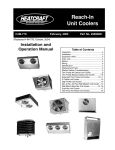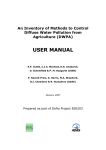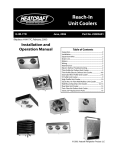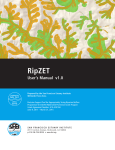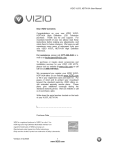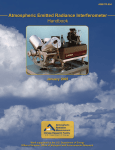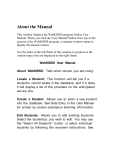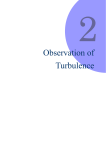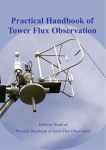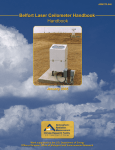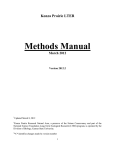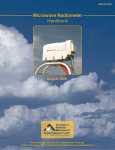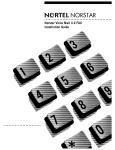Download Bench-Scale Cross Flow Filtration of
Transcript
DOE/SC-ARM/TR-05 Eddy Correlation Flux Measurement System Handbook D.R. Cook M.S. Pekour January 2008 Work supported by the U.S. Department of Energy, Office of Science, Office of Biological and Environmental Research DISCLAIMER This report was prepared as an account of work sponsored by the U.S. Government. Neither the United States nor any agency thereof, nor any of their employees, makes any warranty, express or implied, or assumes any legal liability or responsibility for the accuracy, completeness, or usefulness of any information, apparatus, product, or process disclosed, or represents that its use would not infringe privately owned rights. Reference herein to any specific commercial product, process, or service by trade name, trademark, manufacturer, or otherwise, does not necessarily constitute or imply its endorsement, recommendation, or favoring by the U.S. Government or any agency thereof. The views and opinions of authors expressed herein do not necessarily state or reflect those of the U.S. Government or any agency thereof. D.R. Cook and M.S. Pekour, January 2008, DOE/SC-ARM/TR-052 Contents 1. General Overview ................................................................................................................................. 1 2. Contacts................................................................................................................................................. 1 2.1 Mentor.......................................................................................................................................... 1 2.2 Instrument Developer................................................................................................................... 1 3. Deployment Locations and History ...................................................................................................... 1 4. Near-Real-Time Data Plots ................................................................................................................... 2 5. Data Description and Examples ............................................................................................................ 2 5.1 Data File Contents........................................................................................................................ 2 5.1.1 Primary Variables and Expected Uncertainty.................................................................... 2 5.1.2 Secondary/Underlying Variables....................................................................................... 3 5.1.3 Diagnostic Variables.......................................................................................................... 3 5.1.4 Data Quality Flags............................................................................................................. 4 5.1.5 Dimension Variables ......................................................................................................... 4 6. 7. 5.2 Annotated Examples .................................................................................................................... 4 5.3 User Notes and Known Problems ................................................................................................ 4 5.4 Frequently Asked Questions ........................................................................................................ 5 Data Quality .......................................................................................................................................... 5 6.1 Data Quality Health and Status.................................................................................................... 5 6.2 Data Reviews by Instrument Mentor ........................................................................................... 6 6.3 Data Assessments by Site Scientist/Data Quality Office ............................................................. 6 6.4 VAPs and Quality Measurement Experiments .......................................................................... 10 Instrument Details ............................................................................................................................... 10 7.1 Detailed Description .................................................................................................................. 10 7.1.1 List of Components ......................................................................................................... 10 7.1.2 System Configuration and Measurement Methods.......................................................... 11 7.1.3 Specifications .................................................................................................................. 12 7.2 Theory of Operation................................................................................................................... 12 7.3 Calibration.................................................................................................................................. 13 7.3.1 Theory.............................................................................................................................. 13 iii D.R. Cook and M.S. Pekour, January 2008, DOE/SC-ARM/TR-052 7.3.2 Procedures ....................................................................................................................... 13 7.3.3 History ............................................................................................................................. 13 7.4 Operation and Maintenance ....................................................................................................... 13 7.4.1 User Manual .................................................................................................................... 13 7.4.2 Routine and Corrective Maintenance Documentation..................................................... 13 7.4.3 Software Documentation ................................................................................................. 14 7.4.4 Additional Documentation .............................................................................................. 14 7.5 Glossary ..................................................................................................................................... 14 7.6 Acronyms................................................................................................................................... 14 7.7 Citable References ..................................................................................................................... 14 Tables Table 1: Deployment Information of the ECOR Flux Measurement System .............................................. 2 Table 2: Calculated Quantities for Each 30-min Interval ............................................................................ 3 iv D.R. Cook and M.S. Pekour, January 2008, DOE/SC-ARM/TR-052 1. General Overview The eddy correlation (ECOR) flux measurement system provides in situ, half-hour measurements of the surface turbulent fluxes of momentum, sensible heat, latent heat, and carbon dioxide (CO2). The fluxes are obtained with the eddy covariance technique, which involves correlation of the vertical wind component with the horizontal wind component, the air temperature, the water vapor density, and the CO2 concentration. The instruments used are • a fast-response, three-dimensional (3D) wind sensor (sonic anemometer) to obtain the orthogonal wind components and the speed of sound (SOS) (used to derive the air temperature) and • an open-path infrared gas analyzer (IRGA) to obtain the water vapor density and the CO2 concentration. The ECOR systems are deployed at the locations where other methods for surface flux measurements (e.g., energy balance Bowen ratio [EBBR] systems) are difficult to employ, primarily at the north edge of a field of crops. 2. Contacts 2.1 Mentor David R. Cook Environmental Science Division Argonne National Laboratory, Bldg. 203 Argonne, Illinois 60439-4843 Phone: 630.252.5840 [email protected] 2.2 Instrument Developer Sensor Vendors 3D sonic anemometer, model WindMaster Pro: Gill Instruments, Limited, http://www.gill.co.uk (U.S. distributor: PP Systems, 978.834.0505, [email protected]) IRGA, model LI-7500: LI-COR, Inc., http://www.licor.com/env (LI-COR Environmental, 402.467.3576, 800.447.3576) 3. Deployment Locations and History Table 1 shows the Southern Great Plains (SGP) site locations of the ECOR flux measurement system. 1 D.R. Cook and M.S. Pekour, January 2008, DOE/SC-ARM/TR-052 Table 1: Deployment Information of the ECOR Flux Measurement System Facility SGP/EF1 SGP/EF3 SGP/EF5 SGP/EF6 SGP/EF10 SGP/EF14 SGP/EF16 SGP/EF21 SGP/EF24 AMF 4. Location Date installed Larned, KS LeRoy, KS Halstead, KS Towanda, KS Tyro, KS Lamont, OK Vici, OK Okmulgee, OK Cyril, OK Various March 9, 2004 March 7, 2004 Sept. 9, 2003 Sept. 15, 2003 Oct. 3, 2003 June 3, 2003 Sept. 25, 2003 Feb. 11, 2004 March 18, 2004 Feb. 1, 2005 Status Operational Operational Operational Operational Operational Operational Operational Operational Operational Operational Near-Real-Time Data Plots Near-real-time data plots can be accessed via the Atmospheric Radiation Measurement (ARM) Program Data Quality Health and Status (DQ HandS) Plot Browser (http://dq.arm.gov/plotbrowser/); choose Southern Great Plains (“SGP”) as “Search Site” and “sgp30ecor” as “Datastream” in the corresponding scroll boxes. 5. Data Description and Examples 5.1 Data File Contents Currently, the ECOR systems produce 00- and b1-level data files. Initial processing takes place on the ECOR computer at the end of each half-hour measuring period. The data ingest process adds quality control (QC) flags and generates daily b1-level netCDF files, in keeping with the Atmospheric Radiation Measurement (ARM) Program policy. See a complete ECOR netCDF file header description at http://science.arm.gov/tool/dod/showdod.php?Inst=ecor. Both raw data (00 level) and b1 datastreams are routinely shipped to the ARM Archive. Although b1 data are available though the standard Archive interface, the raw data (00 level) are available only by request to the Archive ([email protected]). 5.1.1 Primary Variables and Expected Uncertainty The ECOR system makes direct measurements at a rate of 10 Hz of the following parameters: • • • • • Three wind components: u, v, and w [m s-1] SOS, s [m s-1], which is used to derive atmospheric temperature, ta [°K] Water vapor density, q [mmol m-3] CO2 concentration, c [mmol m-3] Atmospheric pressure, pa [kPa] 2 D.R. Cook and M.S. Pekour, January 2008, DOE/SC-ARM/TR-052 Table 2: Calculated Quantities for Each 30-min Interval Variable Name in netCDF file Unit -2 Sensible heat flux, H H Wm Latent heat flux, LvE lv_e Wm-2 Momentum flux (dynamic), M K kg m-1s-2 Friction velocity, u Ustar m s-1 CO2 flux, FCO2 Fc µmol m-2 s-1 Mean wind speed (vector averaged), V wind_spd m s-1 Mean wind direction, D wind_dir deg Mean atmospheric temperature, Ta mean_t °K Mean water vapor density, Q mean_q mmol m-3 Mean CO2 concentration, C mean_c mmol m-3 Mean atmospheric pressure, Pa atm_pres kPa * Expected uncertainties of the fluxes, due to measurement accuracies of primary variables, are within the following limits: δH = 6%, δLvE = 5%, δM = 5%, δFCO2 = 4%. 5.1.1.1 Definition of Uncertainty This section is not applicable to this instrument. 5.1.2 Secondary/Underlying Variables The b1-level data file contains all statistics that were used for estimating fluxes and a number of additional variables to support a variety of advanced QC procedures. Calculated statistics include mean, variance, covariance, skewness, and kurtosis of each of the primary measured values: u, v, w, Ta, q, and C. A two-axis coordinates rotation procedure is applied to find vertical turbulent fluxes; all relevant rotated statistics (rotation angles, means, variances, and covariances) are included in the data file. The file also contains standard deviations of wind direction and wind elevation angle. Several air parameters needed to obtain fluxes in conventional “density”-based units (moist air density, specific heat capacity, etc.) are also in the data file. 5.1.3 Diagnostic Variables Several types of diagnostics variables are kept in the b1 file: 1. Data processing: Number of valid samples for each primary variable, number, and means of detected and removed outliers, number of invalid or out-of-range samples. 3 D.R. Cook and M.S. Pekour, January 2008, DOE/SC-ARM/TR-052 2. Sensor status: Serial number of the sensor, number of samples with invalid sonic status flag, number of samples with invalid IRGA status flag (“hardware problem” and “blocked optical path” given separately), IRGA calibration factors used to convert voltages into physical units, and the time lag value used to synchronize sonic and IRGA datastreams. 3. Environmental: Average voltage of IRGA cooler, average temperature inside the IRGA electronics enclosure. 5.1.4 Data Quality Flags The b1 data file contains basic data-quality flags for most important variables; the flags indicate the variable status (bit values), as follows: • 0x0 = value is within the specified range. • 0x1 = value is equal to “missing_value.” • 0x2 = value is less than “valid_min.” • 0x4 = value is greater than “valid_max.” • 0x8 = value failed the “valid_delta” check. 5.1.5 Dimension Variables The global attributes section of the netCDF data file contains geographic coordinates (location) of the ECOR system and the altitude of the ground where the instrument is deployed; the “sensor location” parameter refers to the height of the instrument above the ground. The time variables denote the beginning of the 30-minute measuring period. The sign convention for primary (measured) variables and estimated quantities is positive for upward vertical wind component and upward atmospheric flux. The standard ARM site arrangement has the sonic sensor “North” mark pointing along the boom to the tower; the boom is usually pointing due south; the u wind component is north-south with positive toward the north; the v wind component is east-west with positive toward the west. NOTE: No correction is made to convert the u or v component into the meteorological “north” or “east” wind component when the tower boom is not aligned to the south; the u wind component is “along boom,” the v wind component is “cross boom.” 5.2 Annotated Examples Not available at this time. 5.3 User Notes and Known Problems Measurement inadequacies are known to exist in the eddy covariance measurement technique. Instrument limitations are the source of most of the measurement problem (Cook et al. 2006; Twine et al. 2000). The sources are listed below: 4 D.R. Cook and M.S. Pekour, January 2008, DOE/SC-ARM/TR-052 1. Real temperature values derived from sonic SOS measurements by the WindMaster Pro are significantly overestimated at low temperatures and underestimated at high temperatures. Calibration of nine sonic anemometers in a temperature and humidity-controlled environment showed that each sensor temperature response was biased and had a “slope” that differed significantly from 1:1, ranging from 0.71 to 0.87. Bias has no influence on sensible heat flux estimates, but these “slopes” translate directly into a significant sensible heat flux underestimation (this then affects corrections to the latent heat flux and CO2 flux in the ECOR value-added procedures (VAP) that are based on sensible heat flux). This problem became apparent during final tryouts of the system, when it was too late to change to another sonic model or vendor. A linear correction procedure was implemented to account for the identified sensor deficiency; a more detailed discussion is in Pekour (2004). 2. The ECOR technique has a measurement uncertainty of about 10% just due to calibration issues, biases, vertical alignment, etc. Part of this uncertainty is sometimes reduced through judicious processing of the data, which is done every half hour, mostly in the ECOR VAP post-processing (vertical alignment and sonic SOS temperature corrections are included in the original ECOR datastream data). 3. Flux shortfalls of 10% to 25% are often seen in ECOR results (35% shortfalls are less common, but can occur), even after post-processing, with the smallest shortfalls for bare soil and short vegetation and the largest shortfalls for tall vegetation like forests, corn, etc. Some conditions that can cause the shortfall include: a. Canopy Energy Storage: There is storage of energy in the vegetation canopy and litter that is not accounted for by the eddy covariance technique or in the radiation/soil heat flux measurements (such as measured by the EBBR) that determine the energy balance against which the ECOR measurements are typically compared. b. Sonic Anemometer Frequency Measurement Limitation: The sonic anemometer is physically incapable of properly measuring the lowest frequency components of flux. The size of the sensing volume of the sonic limits its ability to capture larger atmospheric motions that make up the low- frequency component (atmospheric wave motions, horizontal and vertical advection caused by topography, dissimilar surfaces downwind of the main fetch, and changes in air mass). c. Non-steady Atmospheric Conditions: Rapid changes in wind direction, atmospheric stability, temperature, pressure, water vapor content, and CO2 content over a period of seconds to several minutes can be too rapid or sustaining for the covariances to be properly calculated. 5.4 Frequently Asked Questions Where do I get more information about SGP ECOR systems? Contact the instrument mentor at [email protected]. 6. 6.1 Data Quality Data Quality Health and Status The following links go to current data quality health and status results. 5 D.R. Cook and M.S. Pekour, January 2008, DOE/SC-ARM/TR-052 • DQ HandS (http://dq.arm.gov) • NCVweb for interactive data plotting (http://dq.arm.gov/ncvweb/ncvweb.cgi) The tables and graphs shown contain the techniques used by ARM’s data quality analysts, instrument mentors, and site scientists to monitor and diagnose data quality. 6.2 Data Reviews by Instrument Mentor • Visual QC frequency: Daily to weekly • QC delay: Typically 1-3 days • QC type: Instrument mentor routinely views graphic displays that include plots (day courses) of all calculated quantities and comparison plots (time series or scatter plots) of relevant parameters with data from adjacent ECOR/EBBR systems and collocated EBBR (CF only) and Surface Meteorological Observing Station (SMOS) systems (not at EF10 and EF16) (Cook et al. 2006). Monthly reviews of the ECOR data are prepared by the mentor and submitted to the Instrument Mentor Monthly Summary (IMMS) report database; these reports are available at “Related Documents” on the ECOR web page. Beginning in FY2006, Data Quality Reports (DQRs) are not written for missing data or for situations when QC flags clearly show that the data are incorrect (this is true for most of the conditions listed below). DQRs are written for periods when data are incorrect, when the situation is not represented by QC flags in the data, and it is not obvious that the data should have been flagged as incorrect. 6.3 Data Assessments by Site Scientist/Data Quality Office The following guidance has been provided by the ECOR mentor for use by the Data Quality Office in preparing their weekly assessment report for the ECOR systems. ECOR Data Quality Guidance David R. Cook 16 December 2006 Introduction: The best way to tell someone what to look for in assessing the ECOR data is to describe conditions that reflect correct and incorrect data. For the most part, the QC checks provide adequate guidance. However, there are conditions for which the QC flags do not provide the needed guidance to be able to interpret the correctness of the data. Therefore, please use the information below as further guidance. The fc and rho limits were changed in the ingest in late October 2005; therefore, fewer red QC flags should appear for those now. Primary Measurements: fc (CO2 flux), lv_e (latent heat flux), h (sensible heat flux), k (momentum flux), ustar (friction velocity); all of these are calculated quantities. The QC limits set in the ingest are 6 D.R. Cook and M.S. Pekour, January 2008, DOE/SC-ARM/TR-052 appropriate for the measurements (primary and otherwise), although there are times when legitimate values fall outside the QC limits. Nuisance QC Flags: the k and ustar flags are frequently tripped, especially at the E21 Okmulgee forested site. However, it is normally only when the minimum flag is tripped that there is a concern about data quality; values below the minimum usually indicate low wind speed conditions (< 1 m/s) that do not produce accurate flux (fc, lv_e, h, k) measurements. Comparison of Data at Different ECOR Sites: The measurements can generally be favorably compared with those at adjacent sites, keeping in mind that climate conditions from one side of the SGP site to another can differ sharply. However, comparisons cannot be made between the E14 (wheat, corn, stubble, bare soil) or E21 (forest) and the other seven ECORs, which make measurements over grass, because the surface vegetation types are different; such comparisons are likely to show significant differences. Comparison of Data with the EBBR: The only collocated ECOR and EBBR are at E13/E14 (SGP Central Facility). Caution must be used in the comparison of the two systems because they usually see different vegetation surfaces (Cook et al. 2006). The best comparison can be made for straight north or northwest wind directions, when both systems view the same grass surface. For other directions, the two systems are viewing different vegetation surfaces and the fluxes from the two will probably not be similar, unless perhaps, the ground is snow covered. Except for the E14 and E21 sites, sensible and latent heat flux, and wind speed and direction measurements can be compared for adjacent ECOR and EBBR systems (which all view grassland), again remembering that there are likely to be climatologically driven differences. No other measurements can be reliably compared, mostly because the ECOR LI-7500 and sonic anemometer are not meant to produce accurate measurements of anything else that both systems measure. Comparison of Data with the SMOS: SMOS systems are collocated with ECOR systems at seven of the nine ECOR sites (exceptions are E10 and E16). There are no measurements of the two systems that can be directly compared. Wind speed and direction for the two systems are at different heights (SMOS 10 m, ECOR 3 m), so it is expected that the SMOS wind speed will be greater than the ECOR wind speed. Wind direction may be similar but somewhat different if a frontal passage or strong advection is taking place. The ECOR temperatures (sonic and IRGA) and pressure (IRGA) are only approximate and are not meant to provide the same accuracy as the SMOS absolute measurements; therefore, they can be expected to be considerably different under warm weather conditions, especially. Common Conditions Reflecting Correct or Incorrect Data: The ECOR data are only useful for particular wind directions at each Extended Facility (EF). Please use the following resources to help in interpreting the ECOR data from the “new” systems that were installed in 2004: 1. QC flags in the ECOR data. 2. IMMS at http://www.db.arm.gov/IMMS/. 3. SGP EF Surface Conditions Observations (EFSCO) at http://198.124.96.210:591/sfc_cond1/default.htm. 7 D.R. Cook and M.S. Pekour, January 2008, DOE/SC-ARM/TR-052 4. The information below on wind direction dependencies and conditions that commonly cause incorrect data. Wind Direction Dependencies (numbers are wind direction in degrees); the vegetation surfaces and corresponding wind directions over which the fluxes have been measured are listed; wind directions that are not listed are directions for which the fetch is insufficient, and therefore. for which the ECOR flux data are suspect. Appropriate fetch was determined from a 1/70 measurement height to fetch ratio, resulting in a required minimum fetch of 210 m. Changes in surface vegetation type and state can occur with time (refer to the EFSCO): PYE: For some wind directions, the horizontal fetch was not representative of the field in which the AMF was located. Therefore, for the wind direction ranges 66-92 (buildings and trees) degrees, the fluxes are affected by insufficient fetch and surfaces, buildings, or vegetation that are not similar to the local field conditions. NIM: For some wind directions, the horizontal fetch was not representative of the field in which the AMF was located. Therefore, for the wind direction ranges 90-170 (buildings) and 220-280 (trees) degrees, the fluxes are affected by insufficient fetch and surfaces, buildings, or vegetation that are not similar to the local field conditions. FKB: For some wind directions, the horizontal fetch was not representative of the field in which the AMF was located. Therefore, for the wind direction ranges 40-159 and 176-209 degrees, the fluxes are affected by insufficient fetch and surfaces, buildings, and vegetation that are not similar to the local field conditions. EF1: 0-53, 120-360 wheat or wheat stubble EF3: 0-48 pasture 132-260 soybeans, wheat EF5: 80-154 sorghum or wheat 155-260 wheat or wheat stubble EF6: 0-90 grazed pasture 91-360 alfalfa and brome grass 8 D.R. Cook and M.S. Pekour, January 2008, DOE/SC-ARM/TR-052 EF10: 0-90, 270-360 grazed 91-269 grass EF14: 129-265 wheat (2004), corn (2005), soybeans (2006), But normally wheat; 352-85 ungrazed grass EF16: 134-269 pasture 334-360 ungrazed grass EF21: 0-360 mixed deciduous forest (note that for the direction of the tower, 0-30, the data may be suspect) EF24: 80-280 wheat or wheat stubble Some conditions that commonly cause the ECOR primary measurements to be incorrect or missing, plus some advice for interpreting the data are as follows: • Periods of precipitation, fog, and dew (frost) often cause incorrect water vapor and CO2 measurements. This is caused by water laying on the lower window of the LI-7500 CO2/H2O sensor, thereby obstructing the passage of the sensing infrared (IR) radiation (very light precipitation may have little or no effect). The CO2 portion of the instrument is more sensitive to this condition, so it is not unusual for latent heat flux to be correct, even though the CO2 flux is not. I do not write DQRs or indicate time periods in the monthly report for this wetting condition. The data user should look at the ECOR wetness sensor measurement (mid 2006 on), the collocated or nearby SMOS rain gages, or the DQ HandS ECOR plots to determine times of precipitation. You can assume that offscale or spiked readings in the nighttime hours before dawn are normally caused by dew or frost on the CO2/H2O sensor. • Large spikes (positive and negative) in CO2 flux can occur when the flux is essentially zero (see E16, 08/16/05, 0800-0930 GMT). • Friction velocity (ustar) and momentum flux (k) are often flagged during light wind conditions. This is normal, because these measurements, as well as the fluxes of sensible heat flux (h), latent heat flux (lv_e), and CO2 flux (fc) cannot be trusted because of the lack of ability of the sonic anemometer to make proper measurements during very low wind speeds (especially < 1 m/s). • Sudden shifts in wind direction are not handled well by the ECOR coordinate transform routine, often resulting in a spike in the fluxes for a half-hour measurement period. 9 D.R. Cook and M.S. Pekour, January 2008, DOE/SC-ARM/TR-052 • Momentum flux and friction velocity have opposite signs, and mirror each other, because friction velocity is computed from momentum flux; in the DQ HandS plots they are plotted to scales with opposite sign orientations, so they trend together. • ECOR time stamps are for the beginning of the half hour, whereas those for the SMOS and EBBR are for the end of the half hour. Therefore, when comparing data for these systems (such as on DQ HandS plots), the ECOR measurements show a half hour earlier than the commensurate measurements for the SMOS and EBBR. • Plots of water vapor flux (lv_e) and CO2 flux (fc) normally mirror each other: in the DQ HandS plots they are plotted to scales with opposite sign orientations, so they tend to trend together. • During rare occasions, the QC flag for elevation (angle of attack of the wind) is exceeded, usually on the positive side. The QC flag limits for elevation are quite generous; this was done to try to accommodate the large angles that can occur at the forested Okmulgee site EF21. However, the angles at the Okmulgee site can often be much larger than the QC limits because of the very uneven height of trees in the mixed deciduous forest. • Fluxes of CO2, sensible heat, and latent heat at E21 Okmulgee forest are often larger than at other sites, particularly the fluxes of water vapor and CO2; the latter will often be twice what it is at the other ECOR sites. • The plots of data from the forest site at Okmulgee exhibit more noise than is seen at the other ECOR sites; this is expected and normal because the tree structure presents a much rougher and less homogeneous surface than exists for grassland or crops. • When the LI-7500 CO2/H2O serial datastream is not available (pressure and temperature missing), default values are used in the calculation of the CO2 and latent heat fluxes; when default values are used, resulting errors in the fluxes are within the +/- 10% system error. • Missing data periods occur at times; this is usually a site data system collection/communication problem; it can also occur if the ECOR data acquisition computer fails. Missing data are sometimes filled in later from manual or automatic re-collection of the data. 6.4 VAPs and Quality Measurement Experiments An ECOR VAP is under development. The VAP will perform corrections for WPL buoyancy effects (Webb et al.,1980) and sensor separation and frequency attenuation effects, as well as outlier removal and gap-filling of outlier and missing data. 7. 7.1 7.1.1 Instrument Details Detailed Description List of Components Ultrasonic anemometer: WindMaster Pro by Gill Instruments, Ltd. (http://www.gill.co.uk): • Full wind vector in the form of orthogonal wind components u, v, and w Accuracy: − For u and v = 1.5% root mean square (RMS) error for winds below 20 ms-1, 3% otherwise 10 D.R. Cook and M.S. Pekour, January 2008, DOE/SC-ARM/TR-052 − For w = 3% of magnitude • SOS Range: 307 to 367 ms-1 Resolution: 0.01 ms-1 Accuracy: 3% RMS error for winds <20 ms-1, 6% RMS error for winds 20 to 60 ms-1 • Analog inputs Type: eight single-ended or four differential (software selectable) Range: –5 to +5 VDC Resolution: 14 bit Accuracy: 0.05% of full scale (for temperature from +5 to +35°C) 0.1% of full scale (for –40 to +5°C, +35 to +60°C) Open-path CO2/H2O IRGA: LI-7500 by LI-COR, Inc. (http://www.licor.com/env): • water vapor density Range: 0 to 2000 mmol m-3 (software selectable) Accuracy: About 1% (limited by calibration) Precision: About 0.14 mmol m-3 (typical RMS noise). • CO2 concentration Range: 8 to 32 mmol m-3 (software selectable) Accuracy: About 1% (limited by calibration) Precision: About 4 µmol m-3 (typical RMS noise). • Analog outputs Type: Two-user selectable Range: 0 to 5 V DC Resolution: 16 bit Update rate: 300 Hz Data acquisition computer • Single board computer system using Linux operating system • Data collection and initial processing performed with ECOR software (written in C by M. Pekour at Argonne National Laboratory). 7.1.2 System Configuration and Measurement Methods In a typical arrangement, the ECOR system is placed on the north side of a wheat field; sonic and IRGA sensor heads are mounted on a small tower at 3 m above ground level, at the end of a horizontal boom pointing south. The computer and communication devices are installed in an enclosure with basic temperature control (ventilation or heating). One exception to the usual arrangement is the Okmulgee site (EF21), where the ECOR system is installed on a tall tower (15 m above ground, about 3 m above the canopy) in a hardwood forest. The IRGA provides fast-response measurements of water vapor density and CO2 concentration in digital and analog form; the sonic anemometer provides three wind components and the SOS data in digital form 11 D.R. Cook and M.S. Pekour, January 2008, DOE/SC-ARM/TR-052 (retrieved via serial link) at a rate of 10 Hz and performs synchronous digitization of the IRGA analog outputs. The digital datastream from the IRGA is also recorded by the data acquisition computer; it is used to extract IRGA diagnostics values and as a second copy of the water vapor density and CO2 concentration data. The raw datastream is recorded into raw data files by 30-min portions and is processed every half hour by the ECOR computer. The raw and processed data files are transferred to the SGP Central Facility for ingest (conversion into the netCDF format and incorporation of QC flags) and shipment to the ARM Data Archive. 7.1.3 Specifications This section is not applicable to this instrument. 7.2 Theory of Operation The WindMaster Prosonic anemometer uses three pairs of orthogonally oriented, ultrasonic transmitter/receiver transducers to measure the transit time of sound signals traveling between the transducer pairs in both directions. Pairs of measurements made along each axis, 30 times per second, are averaged appropriately to provide a 10-Hz datastream. The wind speed along each axis is determined from the difference in transit times. The SOS is determined from the average transit time along all three axes. The air temperature can be derived from the SOS with a well-known correction for the humidity effects. The IRGA measures water vapor density and CO2 density by detecting the absorption of IR radiation by water vapor or CO2 in the light path. Two IR wavelength bands are used, centered on strong water vapor or CO2 absorption lines. The sensor provides digital (serial RS232) and analog (two 16-bit DAC) outputs. Details of the IRGA principles, design, and performance can be obtained from LI-COR Environmental (http://env.licor.com/PDF_Files/LI7500.pdf). The sonic anemometer samples the gas analyzer analog outputs ten times per second, synchronously with wind measurements, and combines all the data into a single serial datastream. The data acquisition computer continuously records serial datastreams from both sensors and stores them into 30-minute files. Half-hourly flux data processing is accomplished on the same computer, independently of the data acquisition process. Half-hour-averaged ambient air temperature, water vapor pressure, and barometric pressure derived from the sonic anemometer and the IRGA raw data are used in the calculations of moist air density, specific heat of dry and moist air at constant pressure, and heat of vaporization of water necessary for presentation of the fluxes in “density-based” units. Data analysis includes a de-spiking procedure, basic QC of every data point (sensor status, minimum/maximum check), time delay for the sonic data to account for the internal delay in the IRGA, conversion of the SOS into air temperature, and computation of statistics (mean, variance, covariance, skewness, kurtosis, etc.). Two-dimensional (2D) coordinate rotations are applied to the variances and covariances to achieve zero mean vertical wind speed. 12 D.R. Cook and M.S. Pekour, January 2008, DOE/SC-ARM/TR-052 Momentum flux is determined from the correlation between horizontal and vertical wind components in “rotated” coordinates. Similarly, the vertical fluxes of sensible heat, latent heat, and CO2 are determined directly from the correlation between the “rotated” vertical velocity and temperature, water vapor density, and CO2 concentration, respectively. In general, the fluxes calculated as described represent vertical fluxes from a variable area (a footprint) of the surface upwind of the instrument. The size of this area usually varies from 10 to 100 times the height of the sensors above the surface. The footprint depends on surface properties (roughness, displacement height, etc), atmospheric state and stability, and turbulent intensity within the atmospheric surface layer. The surface conditions (crop height, density, and state) can be found in the ECOR section of EFSCO weekly reports (http://198.124.96.210:591/sfc_cond1/default.htm). See Citable References for further discussions. 7.3 7.3.1 Calibration Theory Ideally, the sonic anemometer does not require calibration for either wind or temperature measurements, although the WindMaster Pro SOS channel needs to be calibrated to achieve accurate sensible heat measurement (see Pekour 2004 for more detailed discussion). The IRGA sensors need to be calibrated periodically. The IRGA is calibrated by passing gas of known concentration through a calibration tube installed in the sensor head, so that the tube surrounds the light path over which IR absorption is measured. The zero (offset) is typically calibrated by using “zero” gas or dry nitrogen from a gas cylinder. The gains of the CO2 and H2O channels are calibrated by using a cylinder with a known concentration of CO2 and flow from a water vapor generator (e.g., Licor Inc. LI-610 Dew Point Generator). 7.3.2 Procedures A chemical replacement and calibration procedure was developed and implemented for the ECOR LI-7500 CO2/H20 IRGA sensors. This procedure is available on the ECOR web page. 7.3.3 History The Calibration Test Reports can be accessed here (http://198.124.96.210/menus/caltopmenu.html). 7.4 7.4.1 Operation and Maintenance User Manual No single comprehensive user manual for the ECOR system is available for general use; rather, vendorsupplied documentation on sensors and a collection of procedures prepared by mentors are provided for internal use by Site Operations. 7.4.2 Routine and Corrective Maintenance Documentation 13 D.R. Cook and M.S. Pekour, January 2008, DOE/SC-ARM/TR-052 The ECOR Preventive Maintenance procedures and reports are online at http://198.124.96.210:591/ef_pm1/default_1.htm, as is a database of Corrective Maintenance reports, http://198.124.96.210/menus/cmreports.html. 7.4.3 Software Documentation Contact the instrument mentor ([email protected]) for software documentation. 7.4.4 Additional Documentation This section is not applicable to this instrument. 7.5 Glossary Also see the ARM Glossary. 7.6 Acronyms 2D 3D ARM DQ DQ HandS DQR ECOR EF EFSCO IMMS IR IRGA QC RMS SGP SMOS SOS QC WPL two-dimensional three-dimensional Atmospheric Radiation Measurement (Program) Data Quality Data Quality Health and Status Data Quality Report eddy correlation (flux measurement) Extended Facility EF Surface Conditions Observations Instrument Mentor Monthly Summaries infrared infrared gas analyzer quality control root mean square Southern Great Plains Surface Meteorological Observing Station speed of sound quality control Webb, Pearman, Leuning Also see the ARM Acronyms and Abbreviations. 7.7 Citable References Cook DR, ML Fischer, and DJ Holdridge. 2006. “Comparison of ECOR, EBBR, and CO2FLX System Fluxes.” Abstracts (from poster), Sixteenth ARM Science Team Meeting, Albuquerque, New Mexico, p. 56; March 27-31. 14 D.R. Cook and M.S. Pekour, January 2008, DOE/SC-ARM/TR-052 Kaimal JC and JJ Finnigan. 1994. Atmospheric Boundary Layer Flows: Their Structure and Measurement. Oxford University Press, New York. Massman WJ and X Lee. 2002. “Eddy Covariance Flux Corrections and Uncertainties in Long-Term Studies of Carbon and Energy Exchanges.” Agricultural and Forest Meteorology 113(1-4):121-144. Moore,CJ. 1986. “Frequency Response Corrections for Eddy Correlation Systems.” Boundary-Layer Meteorology 37(1-2):17-35. Pekour MS. 2004. “Experiences with the Windmaster Pro Sonic Anemometer.” In the Proceeding of the 12th International Symposium on Acoustic Remote Sensing, 11-16 July, 2004, Clare College, Cambridge, UK, pp. 137-140. Twine TE, WP Kustas, JM Norman, DR Cook, PR Houser, TP Meyers, JH Prueger, PJ Starks, and ML Wesely. 2000. Correcting Eddy-covariance Flux Underestimates Over a Grassland.” Journal of Agricultural and Forest Meteorology 103:279-300. Webb EK, GI Pearman, and R Leuning. 1980. “Correction of Flux Measurements for Density Effects Due to Heat and Water Vapour Transfer.” Quarterly Journal of the Royal Meteorology Society 106(44):85-100. Wilczak JM, SP Oncley, and SA Stage. 2001. “Sonic Anemometer Tilt Correction Algorithms.” Boundary-Layer Meteorology 99(1):127-150. 15





















